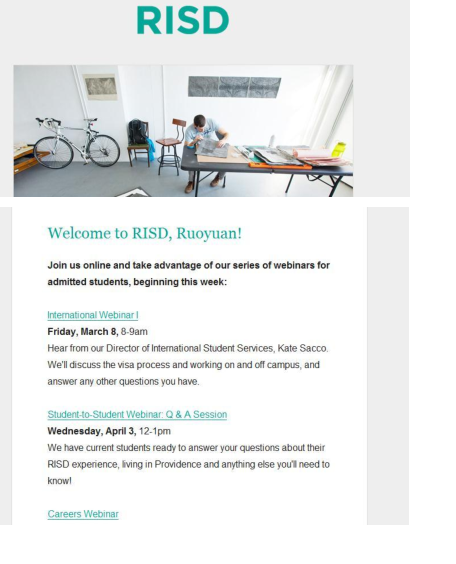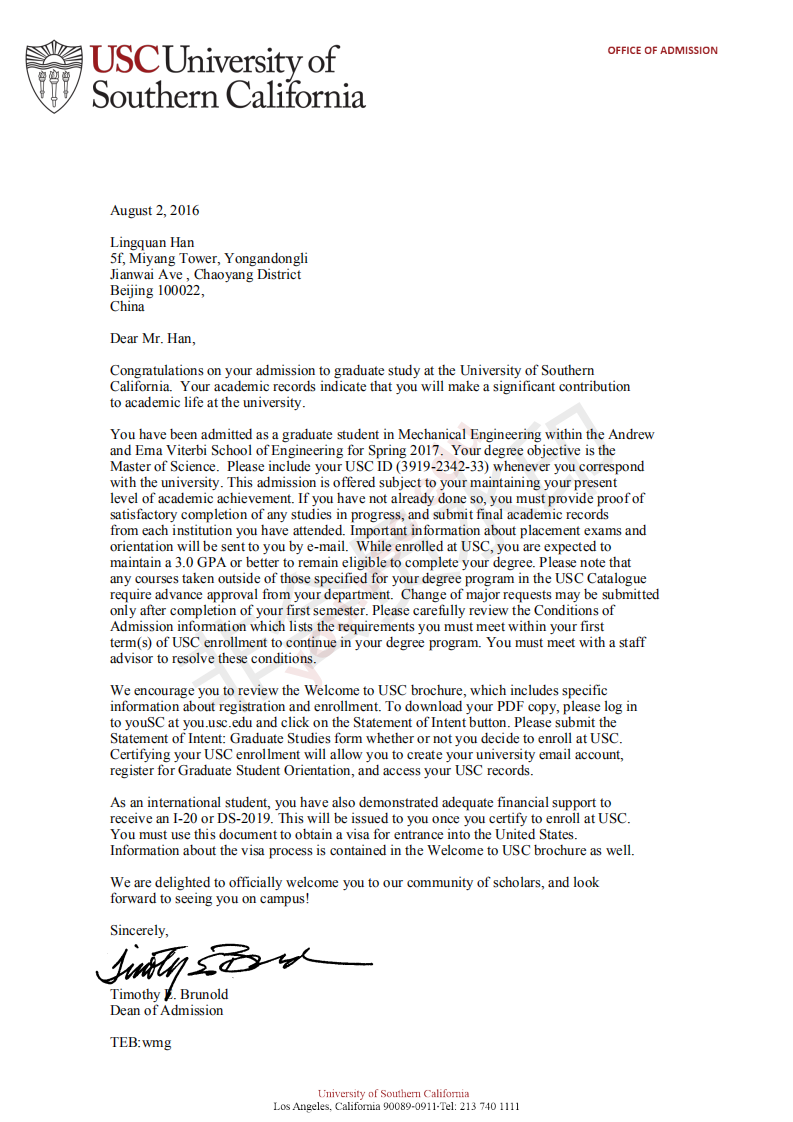申请美国大学艺术类 如何准备作品集.
2017-07-21 435阅读
在申请美国大学的艺术类专业时,与其他专业有所不同,需要提供作品集,招生委员会里有专家对作品集进行审核。下面是纽约时报中的一篇文章,从招生委员会的角度详细介绍了申请美国大学艺术类的高中生如何准备艺术作品。
Guidance Counselor | Art Portfolio Prep
By DANIEL GRANT
THUMBING through one portfolio after another can be a frustrating day’s work for Melissa Morgan, admissions counselor at the Tyler School of Art of Temple University in Philadelphia. “I see so much anime and Pokémon and Grand Tht Auto,” she says. “I see one drawing done 20 times.”
To greater or lesser degrees, grades, class rank and SAT/ACT scores count, but admissions judgments for visual arts programs are largely based on a student’s portfolio of work. That’s true whether the interest is fine arts, fashion, interior or graphic design, architecture or illustration. Yet few students have any idea what they should be submitting when applying. For that matter, neither do guidance counselors and even high school art teachers; many high schools don’t even have art classes.
But where there is a void in education, someone comes along to fill it. Helping applicants get the portfolio right is becoming a business. Portfolio prep classes — an SAT course for budding Picassos — teach tricks of the trade that impress admissions officers. At National Portfolio Day, colleges advise students on how close they are to the right mix and what else is needed.
So what should be in your portfolio?
LESS ANIME, MORE RANGE.
An acceptable portfolio generally contains 15 to 20 drawings, paintings, collages, small three-dimensional works or photographs of these (digital images on CDs are increasingly being submitted, too). “What I need to see are observational drawings from life,” Ms. Morgan says. She wants “a range of drawings and other media that show me the depth and range of a student’s talents.”
By observational drawings, Ms. Morgan means drawings from life — of a human figure, landscape or still life — rather than from a photograph or someone else’s painted scene, and the largest number of samples should be these.
William Swan, head of admissions at Pratt Institute in Brooklyn, says students whose portfolios rlect versatility, exhibiting interest in different realms of life drawing, are likely to have an advantage over those who display narrower concerns. “These kinds of drawings identify a student’s ability to compose a scene, to represent volume, to portray objects accurately and creatively, showing original thought,” he says.
For most fine art and design students, the first year consists of a foundation program that introduces a variety of mediums. The ideal portfolio demonstrates experimentation in at least some of them, like oil, watercolor and pastels. “Schools want to see that students have at least tried other media and are encouraged when they show not necessarily mastery but accomplishment,” Mr. Swan says.
ONE PORTFOLIO FITS ALL FIELDS.
Most students enter a Bachelor of Fine Arts program with limited exposure to fields like architecture, graphic design and interior design. And they don’t make career choices until sophomore year.
“You are applying for a specific degree, the B.F.A., not a specific major,” says Greyson Hong, an assistant director of admissions for the School of the Art Institute of Chicago. “For graphic design, architecture, fine art, it’s all the same portfolio.”
Natalie Lanese, Mr. Swan’s assistant at Pratt, says students who have taken fashion or graphic design classes may submit past assignments to demonstrate their experience, but there is no requirement to do so. “First and foremost,” she says, “we want to see how well they can draw.”
To the extent that a portfolio might differ from one institution to another, it’s more a matter of adapting it to a teaching philosophy than to a field of interest.
At the Pennsylvania Academy of the Fine Arts and the Paier College of Art in Connecticut, drawings that reveal good technical skills are favored over abstraction or art installations. The School of the Art Institute of Chicago, on the other hand, puts greater emphasis on concepts and theory. “Observational drawings are not as sought-after here,” Mr. Hong says. “We prer to see art that combines technical ability with ideas.”
A few places do want specialized portfolios. The San Francisco Art Institute asks design and technology majors to provide digital work along with observational drawings and samples in other mediums. Students at the Fashion Institute of Technology in New York must declare their majors when they apply, and portfolio requirements vary by area of study. For fashion design, for example, portfolios must include 6 to 10 fashion sketches (plus an at-home project given to all applicants). If you’ve made a garment that demonstrates your design sense and your way with a needle, a photo will be a “significant asset to your portfolio.”
Events like National Portfolio Day help applicants get a better idea of what schools look for.
PORTFOLIO DAYS: THE REVIEWS ARE IN.
To help students polish their portfolios, institutions stage something akin to a college fair: participants set up booths, hand out brochures, tout their programs and conduct bri interviews. But the main business of the day is evaluating portfolios brought in by students.
The National Portfolio Day Association, a nonprofit organization of more than 100 degree-granting institutions, runs roughly 35 one-day events at campuses around the country from September through January; anywhere from 15 to 50 institutions participate at any given location.
“For most students, portfolio day is the first time they have received a critical analysis of their work,” says Mark Fetherston, director of admissions at the Milwaukee Institute of Art and Design and chairman of the portfolio association. “Up until then, they have only been told, ‘Oh, I love it’ by family and friends. For some, the experience may be a bit ego-busting.”
In general, though, the tone is positive. “We don’t discourage anyone,” says Terence Peavy, assistant vice president for admissions at the New School University, which includes the Parsons design school in Manhattan. “Artists get enough discouragement throughout their careers.”
Most of the admissions officers have their own ranking system and evaluation sheets, on which they check off each student’s ability in areas like use of line, scale, color and composition; they also assess students’ motivation to learn and capacity for speaking about their work. They comment and take notes on each portfolio: do more direct observational work, edit out those pieces, finish the drawing, include pastels and oil, please apply to our school, try that subject again (on nice paper, not on notebook paper while doodling in class) when you submit the portfolio officially. All this becomes part of a student’s application materials and is then factored into an admissions decision.
No student, however talented, is admitted on the spot, though top-notch candidates may be strongly encouraged. Admissions officers acknowledge they look more favorably on applicants who follow their recommendations.
“If we see 100 portfolios on a given day, maybe a quarter could pass as they are,” Ms. Morgan says. Of the rest, “20 percent will take what we said to heart and work on their portfolios based on our recommendations.”
This year, New York’s National Portfolio Day will be on Nov. 15 at Pratt. New York always has the largest number of participants — 50 programs last year, and more than 2,000 students. Expect long lines and no more than 15 minutes for a portfolio review; an on-campus review might last 30.
But what these reviews lack in depth they make up for in consensus, says Mr. Fetherston. Table to table, students learn how they are viewed, strengths and weaknesses. “I’ll talk to students, and they may walk away thinking, ‘Well, that’s just some guy from Milwaukee,’ ” he says. “But after they’ve spoken with other people at other schools all saying the same things I did, they start to realize that maybe I had it right.”
State education associations also bring together their colleges and universities for portfolio-review days. And as an inducement to get promising students to enroll, some institutions dangle conditional acceptance and scholarships. At its Scholarship Portfolio Days (Nov. 22 and Feb. 7), Converse College in Spartanburg, S.C., will award up to $1,500 in merit aid to studio art majors. The University of Southern Indiana in Evansville has $12,000 to divvy up at its portfolio day, which is on Feb. 21.
PREP CLASSES, FOR A LEG UP.
By conveying what’s expected, Mr. Fetherston says, portfolio days help level the playing field for less-affluent applicants. Portfolio preparation classes can cost thousands of dollars, and the more professional-looking a portfolio, the more likely the student is to receive a scholarship.
“A portfolio prep class clearly works in students’ favor,” says Mr. Swan of Pratt. “The work is more polished. You see a lot of observational drawings, and drawings of the nude model. You don’t draw the nude model in high school, so you know the students are obviously doing something outside of school, which speaks to their commitment.”
Unlike an SAT class, which strives not to teach literature or math but to make students better test-takers, a portfolio prep class is much like a real art class — with a specific product in mind.
Classes are usually offered via continuing education departments. The “Pre-College Portfolio Prep” class at Montserrat College of Art in Beverly, Mass., “includes observational drawing, design, composition, color theory and issues surrounding the making of art,” says Kathleen Burke, its director of continuing education. That’s basically first-year art-school stuff. What distinguishes the portfolio class from other art classes, she says, is that the prep course “is designed to help students develop a strong foundation of skills, develop professional work habits and create a portfolio suitable for college admission.” Montserrat’s class, running seven Saturdays for $245, awards one college credit.
But the price of a portfolio prep course can run much higher. Drew University in Madison, N.J., offers a 10-session class for sophomores, juniors and seniors for $850. The Huntington School of Fine Arts in South Huntington, N.Y., offers 36 three-hour sessions of studio work in an afterschool program that costs between $5,100 and $7,200. The Long Island Academy of Fine Art, in Riverhead and Glen Cove, introduced a 12-session program this year for $1,298 to $2,296, depending on skill level.
Matthew Moore, a senior at Longwood High School in Middle Island, N.Y., took that course. His portfolio, he learned, needed to include a range of older and newer works, not just his best works. “They told me it was good to show how my work has improved,” he says, “that over time I got better, so schools will see that I will improve when I go there, too.”
Roxana Minor took a 12-week portfolio-prep course ($380) at the Bridgeview School of Fine Art in Queens. Her initial portfolio showed skillful, faithful representations of models and still-life scenes. At Bridgeview, she was advised to add more creative elements that revealed her personality. “So I used expressive brushstrokes and exaggerated colors, and the people here really liked it.”
“Here” is the Art Institute of Boston, where she is now a sophomore.
看了招生委员会的介绍,我想准备申请美国大学艺术类的高中生对于自己该如何准备作品集已经有了初步的想法,而艺术作品在整个申请过程中也具有很重要的作用,所以大家一定要做好充分的准备。
申请美国大学艺术类 如何准备作品集申请美国大学艺术类 如何准备作品集在申请美国大学的艺术类专业时,与其他专业有所不同,需要提供作品集,招生委员会里有专家对作品集进行审核。下面是纽约时报中的一篇文章,从招生委员会的角度详细介绍了申请美国大学艺术类的高中生如何准备艺术作品。
Guidance Counselor | Art Portfolio Prep
By DANIEL GRANT
THUMBING through one portfolio after another can be a frustrating day’s work for Melissa Morgan, admissions counselor at the Tyler School of Art of Temple University in Philadelphia. “I see so much anime and Pokémon and Grand Tht Auto,” she says. “I see one drawing done 20 times.”
To greater or lesser degrees, grades, class rank and SAT/ACT scores count, but admissions judgments for visual arts programs are largely based on a student’s portfolio of work. That’s true whether the interest is fine arts, fashion, interior or graphic design, architecture or illustration. Yet few students have any idea what they should be submitting when applying. For that matter, neither do guidance counselors and even high school art teachers; many high schools don’t even have art classes.
But where there is a void in education, someone comes along to fill it. Helping applicants get the portfolio right is becoming a business. Portfolio prep classes — an SAT course for budding Picassos — teach tricks of the trade that impress admissions officers. At National Portfolio Day, colleges advise students on how close they are to the right mix and what else is needed.
So what should be in your portfolio?
LESS ANIME, MORE RANGE.
An acceptable portfolio generally contains 15 to 20 drawings, paintings, collages, small three-dimensional works or photographs of these (digital images on CDs are increasingly being submitted, too). “What I need to see are observational drawings from life,” Ms. Morgan says. She wants “a range of drawings and other media that show me the depth and range of a student’s talents.”
By observational drawings, Ms. Morgan means drawings from life — of a human figure, landscape or still life — rather than from a photograph or someone else’s painted scene, and the largest number of samples should be these.
William Swan, head of admissions at Pratt Institute in Brooklyn, says students whose portfolios rlect versatility, exhibiting interest in different realms of life drawing, are likely to have an advantage over those who display narrower concerns. “These kinds of drawings identify a student’s ability to compose a scene, to represent volume, to portray objects accurately and creatively, showing original thought,” he says.
For most fine art and design students, the first year consists of a foundation program that introduces a variety of mediums. The ideal portfolio demonstrates experimentation in at least some of them, like oil, watercolor and pastels. “Schools want to see that students have at least tried other media and are encouraged when they show not necessarily mastery but accomplishment,” Mr. Swan says.
ONE PORTFOLIO FITS ALL FIELDS.
Most students enter a Bachelor of Fine Arts program with limited exposure to fields like architecture, graphic design and interior design. And they don’t make career choices until sophomore year.
“You are applying for a specific degree, the B.F.A., not a specific major,” says Greyson Hong, an assistant director of admissions for the School of the Art Institute of Chicago. “For graphic design, architecture, fine art, it’s all the same portfolio.”
Natalie Lanese, Mr. Swan’s assistant at Pratt, says students who have taken fashion or graphic design classes may submit past assignments to demonstrate their experience, but there is no requirement to do so. “First and foremost,” she says, “we want to see how well they can draw.”
To the extent that a portfolio might differ from one institution to another, it’s more a matter of adapting it to a teaching philosophy than to a field of interest.
At the Pennsylvania Academy of the Fine Arts and the Paier College of Art in Connecticut, drawings that reveal good technical skills are favored over abstraction or art installations. The School of the Art Institute of Chicago, on the other hand, puts greater emphasis on concepts and theory. “Observational drawings are not as sought-after here,” Mr. Hong says. “We prer to see art that combines technical ability with ideas.”
A few places do want specialized portfolios. The San Francisco Art Institute asks design and technology majors to provide digital work along with observational drawings and samples in other mediums. Students at the Fashion Institute of Technology in New York must declare their majors when they apply, and portfolio requirements vary by area of study. For fashion design, for example, portfolios must include 6 to 10 fashion sketches (plus an at-home project given to all applicants). If you’ve made a garment that demonstrates your design sense and your way with a needle, a photo will be a “significant asset to your portfolio.”
Events like National Portfolio Day help applicants get a better idea of what schools look for.
上12下
共2页
阅读全文留学咨询
更多出国留学最新动态,敬请关注澳际教育手机端网站,并可拨打咨询热线:400-601-0022
留学热搜
相关推荐
- 专家推荐
- 成功案例
- 博文推荐

Copyright 2000 - 2020 北京澳际教育咨询有限公司
www.aoji.cn All Rights Reserved | 京ICP证050284号
总部地址:北京市东城区 灯市口大街33号 国中商业大厦2-3层









高国强 向我咨询
行业年龄 12年
成功案例 3204人
留学关乎到一个家庭的期望以及一个学生的未来,作为一名留学规划导师,我一直坚信最基本且最重要的品质是认真负责的态度。基于对学生和家长认真负责的原则,结合丰富的申请经验,更有效地帮助学生清晰未来发展方向,顺利进入理想院校。
Amy GUO 向我咨询
行业年龄 17年
成功案例 4539人
一切的一切从现在开始.用自己的态度闯出一片天
陈瑶A 向我咨询
行业年龄 16年
成功案例 4879人
拥有大量高端成功案例。为美国哈佛大学、宾夕法尼亚大学等世界一流名校输送大批优秀人才。
齐亚楠 向我咨询
行业年龄 14年
成功案例 3803人
商科案例有哥伦比亚大学等,工科案例有麻省理工大学等,艺术案例有罗德岛大学等。